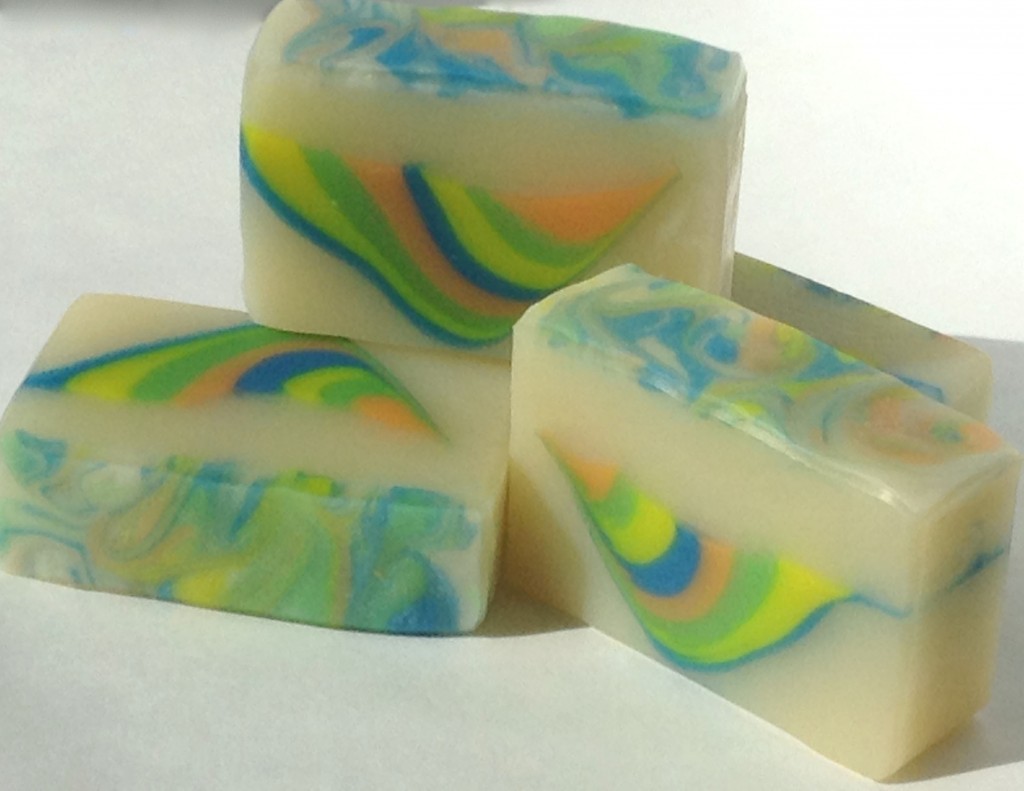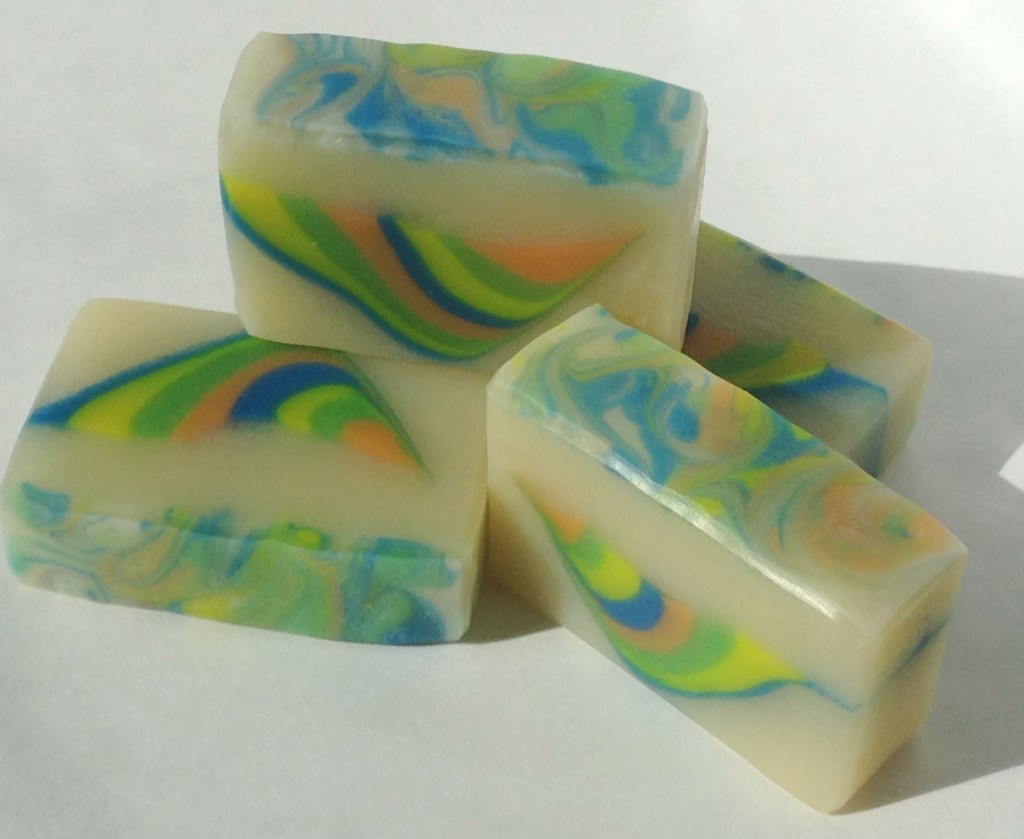This month’s Soap Challenge Club challenge soap is the Dandelion Zebra Swirl created by Vinvela Ebony and described on her blog Dandelion Seifee. Here is my contribution to the challenge:
The recipe I used to create the soap is a slow-moving recipe modified from one recommended by Amy Warden of Great Cake Soapworks:
- 60% olive oil
- 25% coconut oil
- 10% sunflower oil
- 5% castor oil
The resulting soap should be extremely conditioning and great for sensitive skin. I used a Bramble Berry fragrance called Kumquat to scent the soap, and it smells absolutely divine—very fruity and fresh.
I left my soap base uncolored. The sunflower oil does contribute some sort of lightening effect to the soap base. I have noticed when I’ve used it before that the resulting soap has a lighter color than if I didn’t use it at all. However, because sunflower oil makes for a softer soap, it is best not to use too much in a recipe—perhaps no more than 20-25%. Sunflower oil also contributes to a nice, creamy lather.
Typically, I use kaolin clay in my soap, but I am not sure what effect clay might have on speeding up trace, and because I wanted a nice fluid soap for this technique, I left it out.
I mixed my oils and lye at a low temperature—below 90°F. I pulsed my stick blender a few times, mixing just until my oils and lye were emulsified. The colorants I used were neon pigments rather than oxides, as I just recently learned oxides can also speed up trace. I used two pigments from Brambleberry: Tangerine Wow and Fizzy Lemonade. The other two pigments were from TKB: Reformulated Neon Green and Reformulated Neon Blue.
As you can see, the colors are nice and bold, and though the soap base isn’t white, it’s a very pretty light natural shade.
Because of the high amount of soft oils, the soap is definitely softer than my typical soaps; however, I know from experience that high olive oil soaps can become quite hard with a longer cure time.
It’s such an interesting technique. I think I would do it again with some different colors.
Trying this technique gave me some ideas should I decide I want to try the Peacock Swirl again, too. I was able to maintain soap of the consistency I think might be required for the Peacock Swirl when I made this Dandelion Zebra Swirl soap. I think the trick might be to avoid oxides (if I can) for the Peacock Swirl, as it seemed to work great for this soap. Thanks to Amy Warden for teaching me something I didn’t know about oxides!
Here is a last look at the soap from a different angle. I am happy with the swirl on the top, too!




Gorgeous, Dana! Love the colors and the stripes look perfect! I love kumquat too and anything orange and citrusy for that matter. 🙂
Silvia recently posted..Dandelion Zebra or Not?
Thanks, Silvia! It really smells good! I think it will be a nice soap after a good cure, too.
Great colours!
Thanks, Eileen!
I love it!! The base has a beautiful translucent look to it as well. Very pretty colors, and I know that fragrance well. YUM!
Amy Warden recently posted..Live Happy
Thank you! I am guessing it’s the high amount of soft oils that is making the base so translucent. I liked doing this swirl!
Wow Dana….I keep coming back to this one….the colours are gorgeous 🙂
Dianne Forrester recently posted..Dandelion Zebra Swirl Soap Challenge
Thanks, Dianne!
I LOVE IT. Well done. Nice to have the family commentary in the background.
Thank you, Odette! I know the videos are not everyone’s cup of tea. Someone on Pinterest (I pin the videos to a board as one way to share them) comments that there was too much chatter in the background. It wasn’t the same video, but my family gets in on most of my videos.
You got such clear, distinct stripes! Beautiful. I like the translucency as well.
Amy@10th Ave. recently posted..Teardrop Flop–sort of
Thanks, Amy! I think it might be because I used pigments (neons) instead of oxides. Not sure.
I love the colours and you have achieved the technique so well, I didnt know that oxides traced faster, i have so much to learn about colour and thanks for teaching me something about sunflower oil. I need to get some more neon colours I think. well done!
Thank you! I only recently learned that about oxides from Amy, so I give her credit. The sunflower oil I figured out through experimentation, and I guess it’s because the oil is so light, though my soaps are not quite as light when I use sweet almond oil, and it’s really the same color.
Wow! The colors in this soap are absolutely stunning. =)
Anne-Marie Faiola recently posted..Butterfly Swirl Soap Tutorial
Thanks, Anne-Marie! Some of them are Bramble Berry! So is the fragrance!
lovely colors and well done for the dandelion. I enjoy viewing your video
Swanee recently posted..SOAP CHALLENGE CLUB : DANDELION ZEBRA SWIRL
Thanks, Swanee!
I love your bright colors and the natural base color.
Thank you, Cris!
Nice swirls! <3
Victoria
http://maitribathbody.com
Thank you!
That is so pretty!! I love the sound of the recipe, sounds like my kind of oils. I also want to try the Kumquat fo. I’d like a bar of this……………. You selling it soon?
It will be cured on November 10, so just about three weeks, as long as it firms up. I gelled it, but it has a lot of soft oils, and I want to make sure the bars are nice and hard. The Kumquat FO is amazing!
Very striking! Love the colours and translucent look.
Thank you, Barbora!